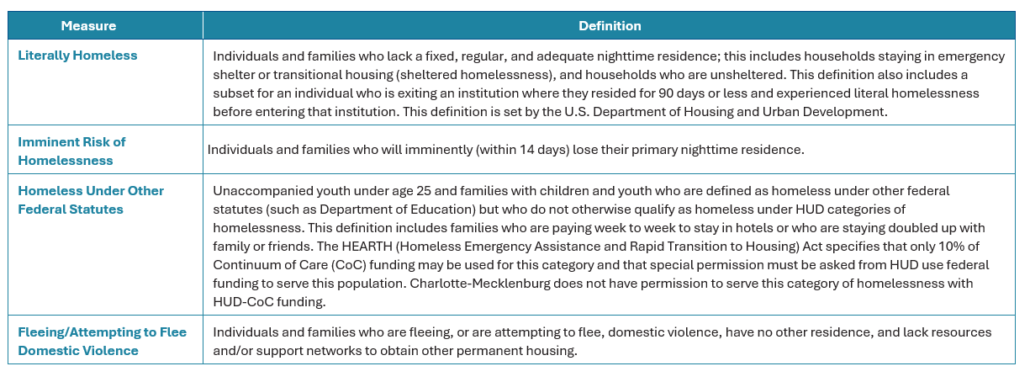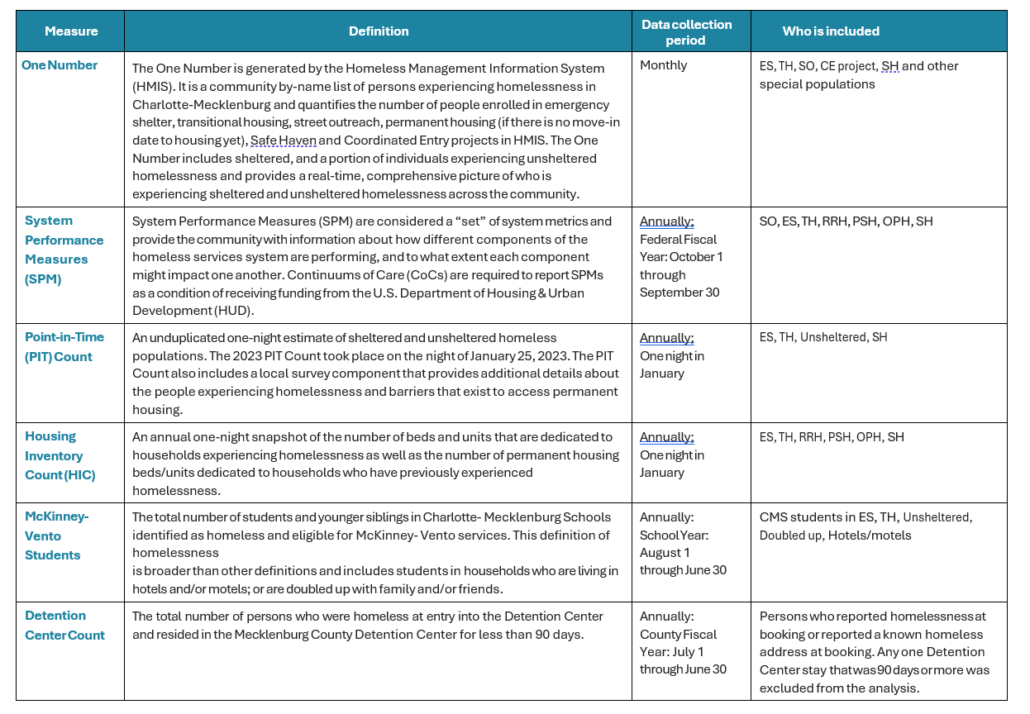Mary Ann Priester
Senior Management Analyst
Mecklenburg County Community Support Services
In December 2023, Mecklenburg County Community Support Services released the 2023 State of Housing Instability & Homelessness (SoHIH) Report which offers a comprehensive overview of the latest data on housing instability and homelessness in Charlotte-Mecklenburg. This report serves as a valuable resource for making informed policy and practice decisions, facilitating optimized resource allocation, and improving systems of care. The report explores three key components of the housing continuum: housing instability, homelessness, and stable housing. This blog is the second in a series of three blogs that take a deeper dive into each of these components.
This blog post takes a deeper dive into the findings from the second component: homelessness. It also shares examples of practices that could be implemented locally and nationally to address homelessness.
HOMELESSNESS
There are several different definitions of homelessness, depending on the context and purpose for which they are being used. Generally, homelessness refers to the condition of individuals or households lacking a fixed, regular, and adequate nighttime residence. This includes living in emergency shelters, transitional housing, or places not meant for human habitation, such as streets or abandoned buildings. The definition may also encompass individuals or families fleeing domestic violence, households living in other temporary living situations such as an institution (such as a detention center or hospital) following an episode of homelessness if they reside in the institution for fewer than 90 days, and those who are at imminent risk of losing their housing and do not have the resources or support networks to secure alternative housing.
While there can be some variation, particularly due to the specific focus and objectives of different funders, many funders tend to align their definitions of homelessness with widely accepted definitions established by government agencies and expert organizations. For instance, in the United States, funders often refer to the definitions provided by the U.S. Department of Housing and Urban Development (HUD) when determining eligibility for funding or when assessing the impact of their programs.
However, subtle differences in definitions may still exist based on the unique priorities, target populations, and programmatic goals of individual funders. Some funders may choose to adopt broader definitions of homelessness to encompass a wider range of housing instability issues, while others may have narrower definitions tailored to specific populations or types of interventions.
The SOHIH report focuses on households that meet the definition of literal homelessness meaning their primary residence is either a publicly or privately operated shelter or a location not suitable for human habitation.
MEASURING HOMELESSNESS
The SOHIH report presents a comprehensive overview of homelessness in Charlotte-Mecklenburg, utilizing various data sources. Six key measures are used to provide insight into the nature of homelessness, including the One Number, System Performance Measures (SPMs), Point-In-Time Count, Housing Inventory Count (HIC), McKinney-Vento Students Count, and Detention Center Count data. The One Number tracks the total count of individuals and households experiencing homelessness, updated monthly. The Point-In-Time Count offers a snapshot of sheltered and unsheltered homelessness on a single night in January, accompanied by detailed surveys. HUD System Performance Measures assess community efforts to prevent and end homelessness, focusing on reducing homelessness and ensuring it is rare, brief, and non-recurring. Additionally, the report includes data on McKinney-Vento students experiencing housing instability and individuals with a history of homelessness in the Charlotte-Mecklenburg Detention Center.
WHAT WE KNOW
- The number of people experiencing homelessness has increased. Homelessness increased 11% from June 2022 – June 2023. People who identify as Black, African American, or African are over-represented in the homeless population (77%), a result of the impacts of systemic racism.
- The average length of time homeless has increased while the median length of time has decreased. In FY22, the average length of time in emergency shelter was 135 days while the median was 55 days. This disparity suggests a small portion of the population is spending long periods of time in shelter.
- Total returns to homelessness have decreased. The percent of people who returned to homelessness after exiting to permanent housing decreased from 24% (or 706 returns) in FY18 to 19% (or 376 returns) in FY22.
- The number of people experiencing homelessness for the first time has increased. Most people (74%) in emergency shelter, safe haven, and transitional housing were experiencing homelessness for the first time in FY22.
- The number of students identified as McKinney-Vento has increased. There was a 14% increase in the number of students identified as McKinney-Vento eligible in the 2022-2023 school year (4,815 vs. 4,206).
APPROACHES TO ADDRESSING HOMELESSNESS
Addressing homelessness requires innovative approaches that go beyond traditional interventions. Here are two innovative strategies:
Interim Housing
Interim housing is an emerging type of housing designed to provide a short-term home for individuals transitioning from homelessness to permanent housing. It features non-congregate sleeping arrangements, individual privacy, security, and a basic level of supportive services. Unlike traditional congregate shelters, interim housing communities provide individual or shared private rooms, along with supportive services such as mental health counseling, employment assistance, and housing navigation support, to help residents stabilize and secure permanent housing. While not the ultimate solution, these communities are intended as a transitional step, typically accommodating stays between three months to a year, with the goal of supporting residents towards long-term housing stability.
Social Impact Bonds (SIBs)
Social Impact Bonds are innovative financing mechanisms that leverage private capital to fund interventions aimed at addressing social issues, including homelessness. In a SIB arrangement, private investors provide upfront funding for social programs, and if predefined outcomes are achieved, the government repays the investors with a return on their investment. This approach shifts the risk away from the government and incentivizes the implementation of evidence-based interventions that can deliver measurable results. For homelessness, SIBs can be used to fund supportive housing programs, employment training initiatives, or other interventions aimed at reducing homelessness and improving outcomes for individuals. By tapping into private capital and focusing on outcomes, SIBs offer a promising avenue for scaling up effective interventions and driving innovation in the field of homelessness.
These innovative strategies offer new ways to address homelessness by prioritizing stability, leveraging private sector resources, and providing low barrier person centered care. By embracing innovation and collaboration, communities can work towards more effective and sustainable solutions to homelessness.
WHY DOES THIS MATTER
Homelessness has broad impacts on individuals and communities affecting physical health, mental-wellbeing, economic stability and mobility, social connections, and overall community cohesion. Addressing homelessness requires a multifaceted cross-systems approach that combines affordable housing initiatives, support services, mental health and addiction treatment, and employment opportunities, along with efforts to reduce discrimination and enhance tenant protections. As the community continues its mission to make homelessness rare, brief, and non-recurring, progress in these areas is imperative.
The 2023 SoHIH report and all complementary material can be found on the Charlotte-Mecklenburg Housing & Homelessness Dashboard https://mecklenburghousingdata.org/state-of-housing-instability-homelessness-reports/
Stay tuned for future blog posts, which will take a deeper dive into the other key findings from the 2023 SoHIH report.




